DO-KHYI (Tibetan Mastiff)
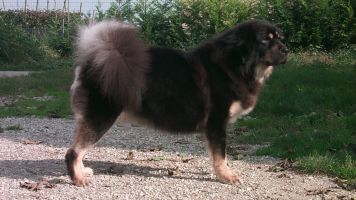
The beautiful subject of the
photos of the sig. Loaded Francisco
FCI-Standard N° 230 / 02. 04. 2004 / GB
ORIGIN : Tibet.
PATRONAGE : FCI.
DATE OF PUBLICATION OF THE ORIGINAL VALID STANDARD : 24.03.2004.
UTILIZATION : A companion, watch and guard dog.
CLASSIFICATION F.C.I. : Group 2 Pinscher and Schnauzer- Molossoid breeds- Swiss Mountain and Cattle Dogs and other breeds.
Section 2.2 Molossoid breeds, Mountain type.
Without working trial.
BRIEF HISTORICAL SUMMARY : The Tibetan Mastiff (Do Khyi) is an ancient working breed of the nomad herders of the Himalaya and a traditional guardian of the Tibetan monasteries. It has been surrounded by great myth since its first discovery in antiquity. From the mentioning by Aristoteles (384-322 b.C.) to the famous writings of Marco Polo, who went to Asia in 1271, all historical reports praise the natural strength and impressiveness of the Tibetan Mastiff- both physically and mentally. Even its bark has been described as a unique and highly treasured feature of the breed. Leading European cynologists of the past, like Martin and Youatt, Megnin, Beckmann, Siber as well as Strebel and Bylandt have intensively covered the Tibetan Mastiff, as they had been fascinated by its origin and function in the Tibetan culture. Some even considered the breed to be the very forefather of all large mountain and mastiff breeds. One of the first known Tibetan Mastiffs to reach Western shores was a male sent to Queen Victoria by Lord Hardinge (then Viceroy of India) in 1847. Later in the 1880s, Edward VII (then Prince of Wales) took two dogs back to England. An early recorded litter of Tibetan Mastiffs was born in 1898 in the Berlin Zoo.
GENERAL APPEARANCE : Powerful, heavy, well built, with good bone. Impressive; of solemn and earnest appearance. Combines majestic strength, robustness and endurance; fit to work in all climate conditions. Slow to mature, only reaching its best at 2-3 years in females and at least 4 years in males.
IMPORTANT PROPORTIONS :
- Skull measured from occiput to stop equal to muzzle from stop to end of nose but muzzle may be a little shorter.
- Body slightly longer than height at withers.
SUGGESTED BREEDINGS by MENANDPETS.COM:
No breeding to signal
if you want to know like signaling yours, contacts: marketing@inseparabile.it
BEHAVIOUR / TEMPERAMENT : Independent. Protective. Commands respect. Most loyal to his family and territory.
HEAD : Broad, heavy and strong. In adults a wrinkle may extend from above the eyes down to the corner of mouth.
CRANIAL REGION :
Skull : Large, very slightly rounded, with strongly pronounced occiput.
Stop : Well defined.
FACIAL REGION :
Nose : Broad, as dark as possible depending on coat colour, well opened nostrils.
Muzzle : Fairly broad, well filled and deep. End of muzzle square. Lips : Well developed and covering the underjaw.
Jaws/Teeth : Jaws strong with perfect, regular and complete scissor bite, i.e. upper incisors closely overlapping the lower incisors and set square to the jaws. Level bite acceptable. Dentition fits tightly.
Eyes : Medium size, any shade of brown and in accordance with coat colour, the darker the better. Set well apart, oval and slightly slanting. Eyelids tightly fitting the eyeball. Expression of dignity.
Ears : Medium size, triangular, pendant, set between the level of the skull and the eye, dropping forward and hanging close to head; carried forward when alert. Ear leathers covered with soft, short hair.
NECK : Strong, well muscled, arched. Not too much dewlap. Covered by thick upstanding mane, not so pronounced in bitches.
BODY : Strong.
Back : Straight, muscular.
Croup : Broad and rather flat.
Chest : Rather deep, of moderate breadth, with good spring of rib, to give heart-shaped ribcage. Brisket reaching to below elbows.
TAIL : Medium length. Set high on line with top of back, carried high, loosely curled over back, when dog alert or in motion; well feathered.
LIMBS
FOREQUARTERS : Straight, well angulated, well covered all over with strong hair.
Shoulders : Well laid, muscular.
Elbows : Neither turned in nor out.
Forearms : Straight. Strong bone.
Metacarpus (Pasterns) : Strong, slightly sloping.
HINDQUARTERS : Powerful, muscular, with good angulation. Seen from GO BACK TO LIST, hindlegs parallel.
Upper thigh : Rather long; strong, with good hard muscles, but not bulging.
Stifle : Well bent
Hock : Strong, low set.
Dewclaws optional.
FEET : Fairly large, strong, round and compact, with good feathering between well-arched toes.
GAIT / MOVEMENT : Powerful, but always light and elastic: with good reach and drive. When speed increases tends to single track. When walking appears very deliberate. Capable of functioning over a varied terrain with stamina and suppleness.
COAT
HAIR : Quality of greater importance than quantity. Coat harsh, thick, top coat not too long, with dense and rather wolly undercoat in cold weather which becomes rather sparse in warmer months. Males carry noticeably more coat than females. Hair fine but harsh, straight and off-standing. Never silky, curly or wavy. Neck and shoulders heavily coated, giving mane-like appearance. Tail bushy and well feathered; hindlegs well feathered on upper rear parts.
COLOUR : Rich black, with or without tan marking; blue, with or without tan markings; gold, from rich fawn to deep red, sable. All colours to be as pure as possible. Tan ranges from a rich chestnut to a lighter colour. White star on breast permissible. Minimal white markings on feet acceptable. Tan markings appear above eyes, on lower part of legs and underside of tail. Tan markings on muzzle; spectacle markings tolerated around eyes.
SIZE :
Height at the withers : Dogs : 66 cm (26 ins) minimum,.
Bitches : 61 cm (24 ins) minimum..
FAULTS : Any departure from the foregoing points should be considered a fault and the seriousness with which the fault should be regarded should be in exact proportion to its degree.
SEVERE FAULTS :
- Lacking physical condition and fitness.
- Head light or heavily wrinkled.
- Pendulous flews.
- Pronounced dewlap.
- Large and/or low set ears.
- Light eyes or staring expression.
- Weak pigmentation, particularly of nose.
- Barrelled ribs.
- Tightly curled tail over hips.
- Over angulated or straight hindquarters.
- Heavy constrained movement.
- Under minimum height, tolerance 2 cm.
ELIMINATING FAULTS :
- Aggressive or overly shy.
- Undershot or overshot mouth.
- All other colours than above mentioned e.g. white, cream, grey, brown (liver), lilac, brindle, particolours.
Any dog clearly showing physical or behavioural abnormalities shall be disqualified.
N.B. : Male animals should have two apparently normal testicles fully descended into the scrotum.
Automatic translate from inseparabile.com
THE HISTORY - Feature gives: Uli Gelbrich - Tibetanische Hunde
HEALTH
TOELETTATURA
CHARACTER
CURIOSITA'
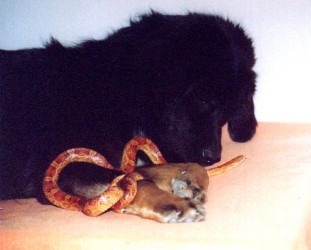
STANDARD
GENERAL ASPECT:
Powerful, strong, very constructed, equipped of good
skeleton.
Imposing, solemn but of kind appearance.
CHARACTERISTICS:
Good companion, dog from guard
and defense, slow to mature only catch up the best of s to 2 - 3
years for the females and at least 4 years for the males.
TEMPERAMENT:
Mistrustful and protecting.
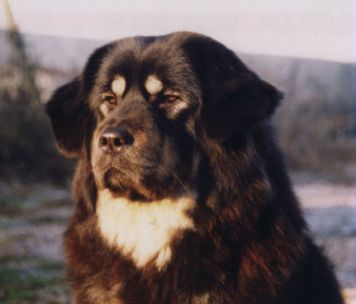
HEAD And
SKULL:
Enough wide, strong and sturdy. Occipite massive
skull with and stop strongly defined. The length of the skull from
the occipite ones to stop the equivalent to that one of the snout
from the stop to the estremit of the tartufo, but the nasal cane pu
also to be hardly devout short.
Enough wide, beautiful observed
full load and squared snout from every side. Large Tartufo, very
pigmented and narici very opened. Labbra very developed moderately
hanging.
Some corrugamento in the head, in mature ET, extends
gives over the eyes end under the angle of the mouth.
EYES:
Many expressing to you, of medium
dimension, some brown shading. Very it distances to you, ovals and
leggermente inlinati.
ORECCHIE:
Of medium
largeness, triangular, hanging, low, falling back in ahead and
supported capacities to the head. Risen when in attention. Covered
with soft and short hair.
SET OF TEETH:
Closing
to scissor. Strongly jaw with perfect, regular set of teeth and
completes. I recorded to you advanced they cover the inferiors to
tightened contact and are places to you in square to the jaws.
Accepted closing to tenaglia. Essential that the dentizione joins
watertight in order to maintain the shape squared of the snout.
NECK:
, strongly muscoloso, arch. Not excessive
Giogaia. Wrapped from one driven in criniera irsuta.
FRONT:
Very disposed, muscolose shoulders, with
strong skeleton. Straight legs with strong pasterns and a po'
oblique; very covered from driven in hair.
BODY:
Strongly, with straight and muscolosa back, nearly
imperceptible rump. Rather deep thorax than moderated width, with
ribs reasonably folded to giving to the thoracic case a shape to
heart. The sterno it comes down under the elbows. The length of the
leggermente advanced body to the height of the garrese.
POSTERIOR:
Powerful, muscolosi, with good very
slanted angles-shot and grasselle, garretti solid and very
reductions. Posterior, approvals give GO BACK TO LIST, parallels. The removal
of the spurs (single or double) optional.
FEET:
Enough large, strong and compact. Feet from cat very
supplies of hair between the fingers.
TAIL:
Of
medium length, it does not exceed the garretto. Attacked high on the
line of the back. Goffered on the back on one side. Very supplied of
hair.
SAILING POINT And MOVEMENT:
Powerful,
always light and elastic. In velocit it stretches to approach the
limbs the median plan (single-track). When it walks appears slow and
much cautious one.
HAIR:
In the remarkablly
devout male present who in the female. The qualit of better
importance of the quantit. Mainly enough along, folto, with driven
in sottopelo in the cold season that dirada in the warm devout
months. Hair fine but hard, straight and separated. Never light,
curly or undulated. Driven in sottopelo, when present, the rather
lanoso one. Neck and shoulders have abundant hair giving a criniera
appearance. Tail folta, densely covered; thighs very covered in
every they part.
COLORS:
Black intense, black
focato, brown, several shadings of the gold, several shadings of
gray, also gray with golden spots. The focatura goes from one devout
shading clearly much intense one to a color. E' admitted the star
white woman on the chest; picole parts are accepted white women in
legs. The focature appear over the eyes, in the inner part of the
limbs and to the estremit of the tail.
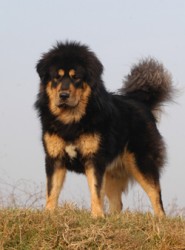
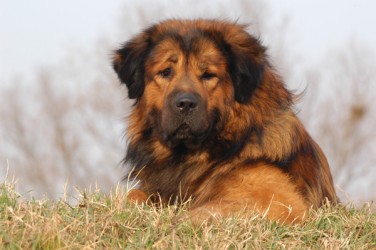
in the photos:
a black one focato (black and tan)"Shang-Hai' s Yankee Doodle" and
red gold "a Samantabhadra' s Namgyal Senge". By:Franzo-Belletti
Photo
RANSOM:
Males minimal 66 cm, females 61 cm.
DEFECTS:
Whichever scostamento how much previously said must be
considered like defect that sar penalized in function of its gravit.
The males must apparently have two testicoli normal reductions from
the scroto.
ORIGINS:
Mountains of the Himalayas
of the east, Bhutan, Sikkim and Tibet.
we thank the sig. Loaded Francisco in order to have collaborated to the realization of this card with witnesses and photo of its beautifulst subjects